How Long Does Sake Last After Opening
After opening, sake typically lasts 1-2 weeks when properly stored in your refrigerator at 35-40°F (2-4°C). You'll get the best flavor experience within the first 7 days, with premium varieties potentially lasting up to a month due to higher alcohol content. To maximize freshness, seal the bottle tightly and store it upright away from strong-smelling foods. Watch for signs of spoilage like dark yellow coloring, unexpected cloudiness, or off-putting aromas. While sake remains safe to drink after two weeks, oxidation will impact its taste and aroma. Understanding proper storage techniques can greatly extend your sake's enjoyment window.
This post may contain affiliate links. If you make a purchase through these links, I may earn a commission at no additional cost to you. Additionally, portions of this post may be generated using artificial intelligence (AI) technology. While we strive for accuracy, please be aware that AI-generated content may not always be perfect and should be fact-checked when necessary.
The Spatula Scoops
- Sake typically remains drinkable for 1-2 weeks after opening when properly stored in the refrigerator at 35-40°F (2-4°C).
- Premium sake varieties may last up to one month after opening due to higher alcohol content and acidity levels.
- Unpasteurized nama sake should be consumed within one week of opening as it deteriorates faster than pasteurized varieties.
- Best flavor experience occurs within the first 7 days after opening, with optimal consumption recommended within 3 days.
- Using proper sealing techniques like vacuum sealers or transferring to smaller containers can extend freshness up to two weeks.
Understanding Sake Shelf Life
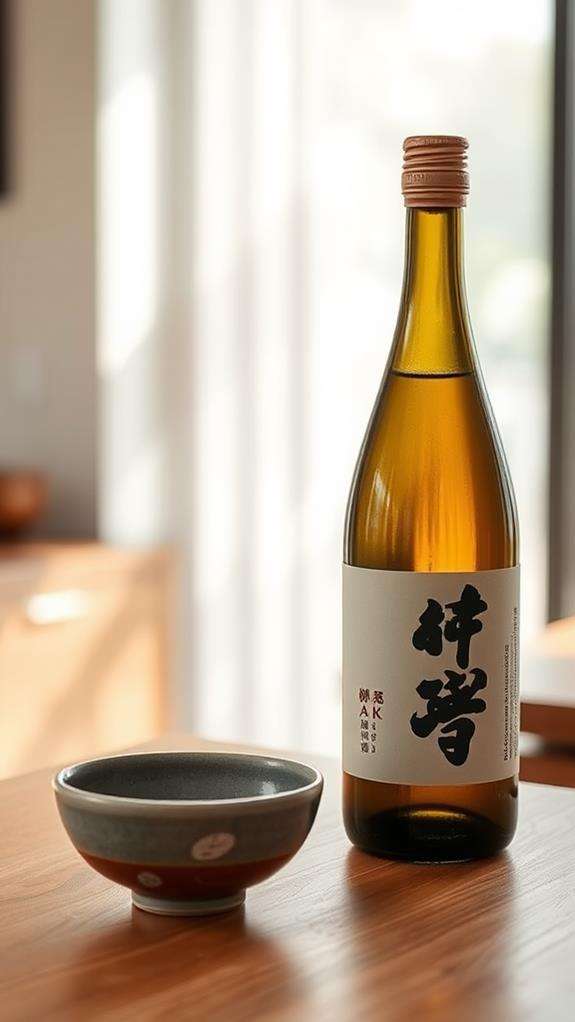
Sake's shelf life becomes a critical consideration the moment you break the seal on a new bottle. When you've opened your sake, you're starting a countdown that typically runs between one and two weeks, during which you'll want to enjoy the beverage at its peak quality. The clock starts ticking as oxidation begins to affect the delicate flavors and aromas that make sake special.
While your opened bottle can technically last up to a month when properly refrigerated, you'll notice the quality of the sake beginning to decline after just a few days. To maintain the best drinking experience, you'll want to consume your sake within the first week after opening. This is particularly important for more delicate varieties, such as nama sake, which deteriorates faster than its pasteurized counterparts. You can extend the shelf life by ensuring proper storage – keep your opened bottle tightly sealed in the refrigerator and away from light. While the sake won't necessarily become unsafe to drink after the recommended window, you'll want to check for any unusual aromas or flavors before consuming sake that's been open for more than two weeks.
Signs of Spoiled Sake
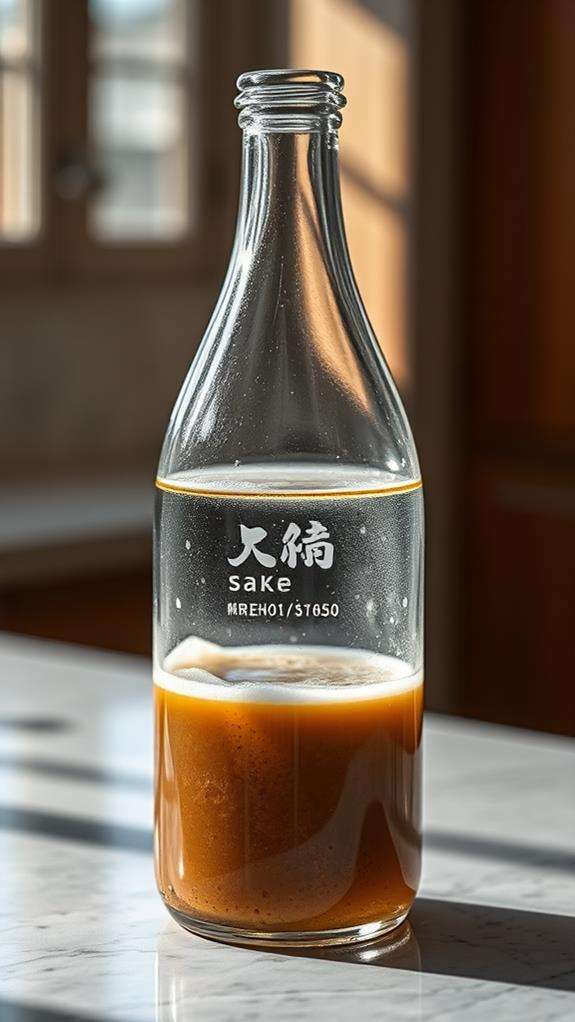
Spotting spoiled sake doesn't require expert knowledge once you know the key indicators. The first thing you'll want to check is the color of your stored sake – if it's turned dark yellow or amber instead of its usual clear appearance, you're likely dealing with degraded quality. You'll also notice a distinct pungent or moldy smell that's hard to miss when sake has gone bad.
When examining your sake, look for any unexpected cloudiness or floating particles, unless you're dealing with nigori sake, which is naturally cloudy. If your clear sake has become murky, it's probably spoiled. The ultimate test comes down to taste – if you detect an off or unpleasant taste that seems unusual, don't continue drinking it. Most signs of spoilage result from improper storage conditions, particularly when sake is exposed to direct light, excessive heat, or too much air. To prevent these issues, you'll want to keep your sake in a cool, dark place and guarantee the bottle is properly sealed after each use. Remember, proper storage is essential for maintaining sake's delicate flavors and preventing unwanted changes in its characteristics.
Proper Storage Methods
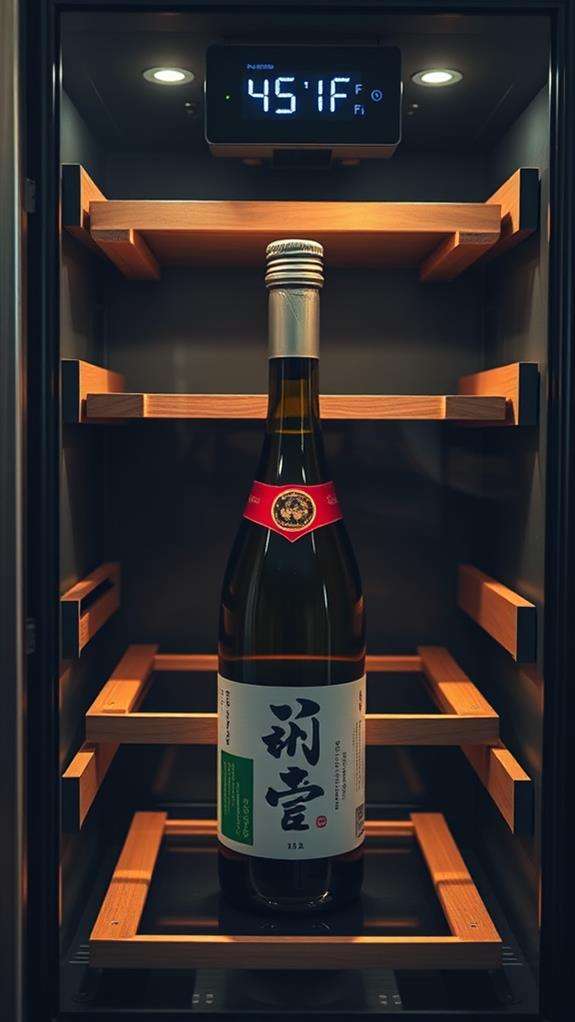
Your opened sake's lifespan depends heavily on proper temperature control and effective sealing techniques, with refrigeration at 35-40°F (2-4°C) being your best defense against premature spoilage. To maintain your sake's quality, you'll need to seal it tightly using either the original cap, a vacuum sealer, or by transferring it to a smaller container that minimizes air exposure. When storing your sake in the refrigerator, always keep the bottle upright and away from strong-smelling foods, as the beverage can absorb unwanted aromas even through a sealed cap.
Temperature Control Essentials
Keeping your opened sake at the right temperature plays an essential role in preserving its delicate flavors and aromas. To maintain the best quality of your sake, you'll want to store it in a consistently cool place, ideally in your refrigerator, where it can last between one to two weeks. When you store sake at proper refrigeration temperatures, you're markedly slowing down the oxidation process that naturally occurs once the bottle is opened.
Temperature fluctuations are your opened sake's enemy, as they can trigger unwanted chemical reactions that'll degrade your sake's quality more quickly. Even if you're planning to serve your sake warm later, don't store it at room temperature. Instead, keep it refrigerated until you're ready to heat it for serving. The combination of cool temperatures and an airtight container can extend your sake's drinkability up to a month. Remember to place your sake bottle away from any light sources in your refrigerator, as UV exposure can compromise its flavor compounds. If you've got a wine refrigerator, that's another excellent option for maintaining the consistent cool temperatures your sake needs.
Sealing Techniques Matter
Proper sealing techniques fundamentally determine how long your opened sake will maintain its quality. When you're sealing opened sake, you'll need to guarantee there's minimal air exposure to prevent oxidation from degrading its delicate flavors and aromas. Even small gaps in your seal can lead to considerable deterioration, affecting your overall drinking experience.
To preserve quality effectively, you've got several reliable options at your disposal. Consider using a vacuum sealer, which removes excess air before resealing the bottle, greatly extending your sake's shelf life. If you don't have a vacuum sealer, try transferring your remaining sake into smaller bottles that better match the volume of liquid – this reduces the amount of air space above the sake, limiting oxidation. When using the original bottle, ensure you're creating airtight seals by tightening the cap firmly and checking for any potential leaks. For refrigerated sake, proper sealing becomes even more essential, as it helps maintain freshness for up to two weeks after opening. Remember, the effectiveness of your sealing method directly impacts how long your sake stays enjoyable, so taking extra care with this step is well worth the effort.
Temperature and Light Effects
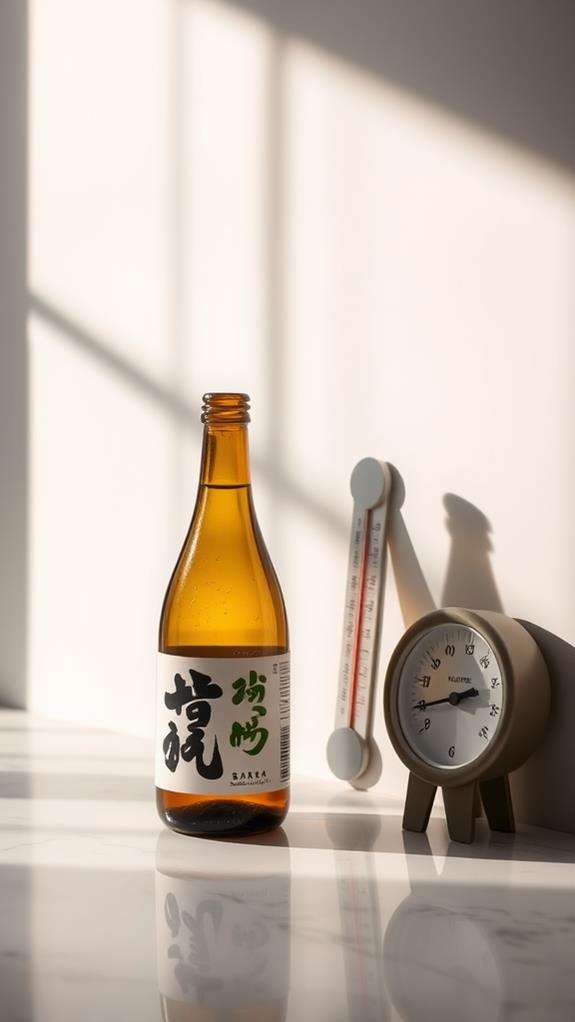
Temperature and light are two vital factors that determine how long your opened sake maintains its quality. When you expose your sake to higher temperatures, you'll accelerate the oxidation process, which quickly degrades both flavor and aroma compounds. That's why you'll want to keep your opened bottles in the refrigerator, where temperatures remain consistently cool and controlled.
Light exposure, particularly UV rays, can be especially damaging to your sake's composition. You'll notice that most sake bottles come in dark brown glass, and there's good reason for this – the specialized packaging helps protect the drink's amino acids and vitamins from breaking down. To maintain your sake's ideal quality, you'll need to store it in a cool, dark place, ideally at temperatures below 5°C. This is particularly important for delicate varieties like namazake, which are more susceptible to temperature-related deterioration.
Remember that temperature fluctuations can trigger unwanted chemical reactions in your sake, so maintaining a steady, cool environment is essential. By controlling both temperature and light exposure, you'll greatly extend your opened sake's lifespan and preserve its intended taste profile.
Best Drinking Window
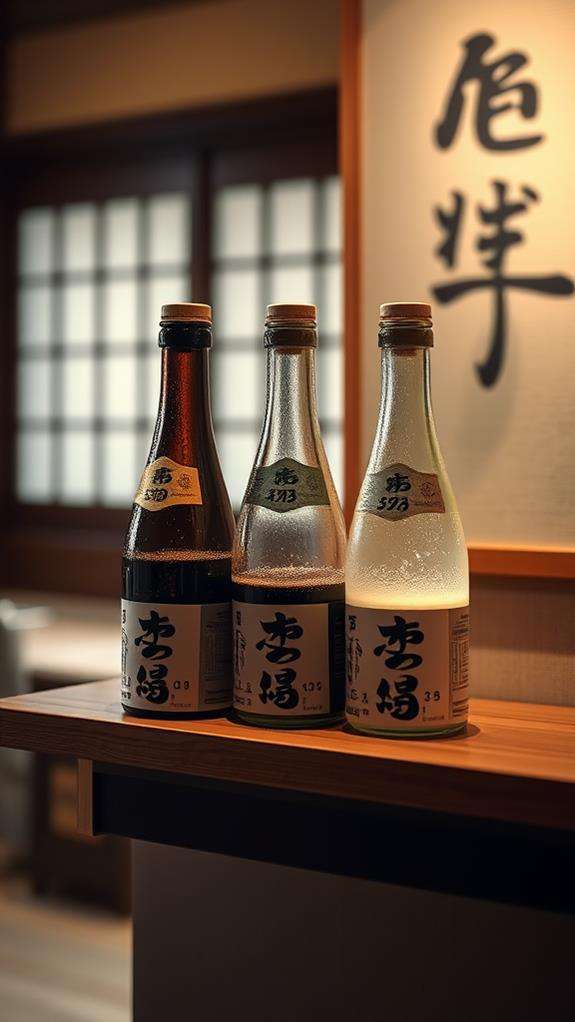
You'll get the best flavor from your opened sake within the first 7 days, with premium varieties showing noticeable changes in taste and aroma after this window. Watch for telltale signs of quality loss, including a yellowing color, vinegar-like smell, or off-putting flavors that weren't present when you first opened the bottle. While some sake enthusiasts enjoy the subtle evolution of flavors during the first two weeks, you're better off finishing your bottle within the first week to experience the brewer's intended taste profile.
Peak Flavor Timeline
For the most exceptional sake experience, plan to finish your opened bottle within the first three days. During this initial window, you'll enjoy the sake's peak flavor profile, complete with its delicate aromas and nuanced taste characteristics that make this beverage so special.
If you can't consume your sake within the three-day ideal window, don't worry – you've still got some time. When properly stored in your refrigerator, opened sake typically maintains its quality for up to two weeks. However, you should know that premium varieties might give you a bit more flexibility, sometimes lasting up to a month due to their higher alcohol content and increased acidity levels.
Pay special attention if you're enjoying nama sake (unpasteurized varieties), as these are more delicate and should be consumed within a week of opening. After the two-week mark, while your sake won't spoil in a way that makes it unsafe to drink, you'll notice its flavors becoming less vibrant and its aromatic qualities diminishing due to oxidation. To maximize your enjoyment, try to plan your sake consumption within these timeframes, particularly focusing on those first significant days after opening.
Signs of Quality Loss
Several telltale signs will alert you when your sake's quality begins to decline after opening. You'll notice changes in color, aroma, and taste that indicate your bottle of sake isn't at its peak anymore. Watch for any darkening of the liquid or unexpected cloudiness, as these visual cues often signal deterioration.
When evaluating your sake's condition, trust your nose. Fresh sake should have a clean, pleasant aroma. If you detect any off-putting or sour smells, it's likely past its prime. Premium varieties tend to maintain their quality longer than standard ones, but you'll still want to monitor them closely after opening.
To guarantee you're enjoying sake at its best, you should plan to have it consumed within one to two weeks of opening. Keep in mind that the most significant quality loss occurs during the first week, so you'll want to be particularly attentive during this period. If you're uncertain about your sake's condition, remember that it's better to err on the side of caution. While older sake might not make you sick, it won't deliver the delicate flavors and aromas that make this beverage special.
Alternative Uses Beyond Expiration
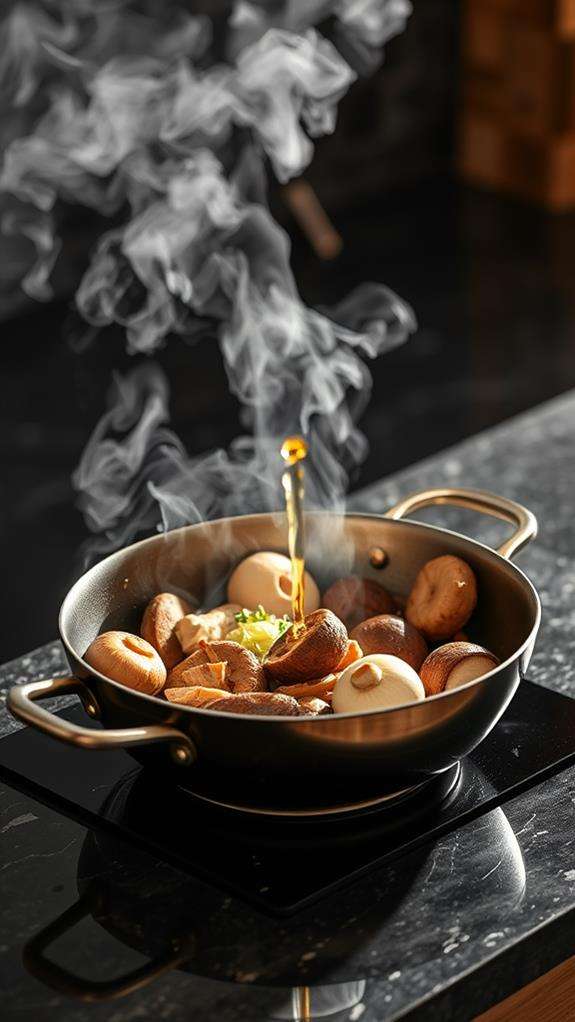
When sake begins to lose its drinking appeal, don't rush to discard it – numerous creative alternatives exist beyond its prime. You'll find that open sake can transform into a versatile cooking ingredient, adding depth and complexity to various dishes. Whether you're simmering vegetables, creating marinades, or enhancing pasta sauces, this fermented rice wine can still contribute significant flavor to your culinary endeavors.
Even expired sake maintains its utility in the kitchen, offering you multiple ways to minimize waste while maximizing value. You can incorporate it into hot pot dishes, where it'll blend seamlessly with other ingredients, or use it to tenderize meats in marinades. If you're feeling experimental, try converting your old sake into homemade vinegar by mixing it with water and allowing it to ferment naturally. For simpler culinary applications, consider adding it to potato dishes or stir-fries where its umami notes can enhance the overall flavor profile. The key is understanding that while sake may no longer be ideal for drinking, its potential as a cooking component remains largely intact, offering you countless opportunities to repurpose this traditional Japanese beverage.
Frequently Asked Questions
Does Sake Go Bad Once Opened?
Yes, sake does go bad after you've opened it. You'll want to consume it within 1-2 weeks for the best quality, though it can last up to a month if you store it properly in the refrigerator. Once opened, sake begins to oxidize, which affects its taste and aroma. Watch for signs of spoilage like vinegary smells, cloudiness, or off-putting flavors. Unpasteurized (nama) sake is particularly delicate and will spoil more quickly than other types.
Do You Need to Refrigerate Sake?
Yes, you'll definitely need to refrigerate sake after opening it. While unopened bottles can stay in a cool, dark place, once you've broken the seal, refrigeration becomes important to slow down oxidation and preserve the drink's delicate flavors and aromas. This is especially vital for unpasteurized sake (Namazake), which needs storage below 5°C. For the best taste experience, you should always keep your opened sake in the fridge to maintain its quality.
Can You Drink 20 Year Old Sake?
You shouldn't drink 20-year-old sake, especially if it's been opened. While it might not make you sick, the quality will be severely compromised. When sake's exposed to air for that long, it loses its delicate flavors and aromas, often developing unpleasant characteristics. If you've got an unopened bottle that's been properly stored, it's still likely past its prime. For the best experience, you'll want to enjoy sake within two years of production.
What Does Spoiled Sake Look Like?
When your sake has gone past its prime, you'll notice several telltale signs. The color should alert you first – if it's turned a dark yellow or amber shade instead of its usual clear appearance, that's trouble. You'll also want to watch for cloudiness or sediment that shouldn't be there (though don't confuse this with nigori sake). If you spot any mold or notice a vinegar-like smell, it's definitely time to say goodbye to that bottle.





